
July 15, 2008
In my never-ending quest to give both sides of various intellectually stimulating issues, here is part two of Monday’s discussion on whether or not Mokele-Mbembe, if discovered, might be found to have a trunk.

University of Portsmouth vertebrate palaeontologist and science writer Darren Naish (above) has a contrary opinion to that of the one highlighted here by reconstruction artist Bill Munns yesterday, on whether or not trunks existed on sauropods and a variety of other fossil animals.
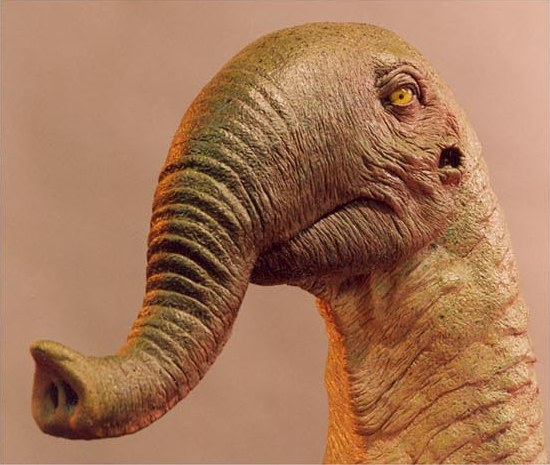
For the sauropods, Naish emails me this comment about Munns’ images (one, shown above) and the pro-trunk theory:
“Very cool. But the palaeontological community votes emphatically no on trunks in sauropods – recent studies of blood vessel patterns, predictions about skull musculature, and brain anatomy all confirm that none of the anatomy required for a trunk was present. It was never a good idea. Also, Munns seems unaware of recent work showing that the actual soft-tissue nostrils of sauropods were not located in the bony nares, but further down the snout and in a more ‘typical’ position for a tetrapod.”
Naish passes along that some of the relevant technical publications are:
Knoll, F., Galton, P. M. & Lopez-Antonanzas, R. 2006. “Paleoneurological evidence against a proboscis in the sauropod dinosaur Diplodocus.” Geobios 39, 215-221.
Witmer, L. M. 2001. “Nostril position in dinosaurs and other vertebrates and its significance for nasal function.” Science 293, 850-853.
Okay, no trunks on dinosaurs, in Darren Naish’s opinion, but what about those speculated for fossil mammals?
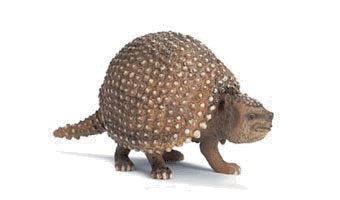
Schleich company’s glyptodont.
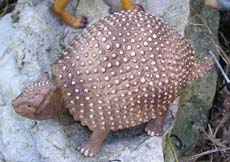
In talking about the Glyptodon model above, Naish writes:
“Schleich obviously opted not to follow Gillette & Ray’s (1981) idea (earlier proposed by Senechal in 1865) that glyptodonts had a short tapir-like proboscis: so far as I can tell, these authors favoured the idea of a proboscis simply because they thought that the neck morphology of glyptodonts would have prevented the mouth from reaching the ground, ergo a proboscis must have existed. I’m not convinced: glyptodont skulls lack the features present in living mammals that possess proboscides… but more on this another time.”

On the possible presence of proboscides in glyptodonts, Naish did end up covering this recently, here. He says, in part:
“Some sclerocalyptine glyptodonts had particularly large, strongly pneumatised fronto-nasal sinuses that gave their nasal regions a massively bulbous appearance (this is particularly prominent in species of the Pliocene-Holocene sclerocalyptine Sclerocalyptus). Zurita et al. (2005) argued that this was an adaptation for the cold, arid conditions experienced by these animals, particularly by the Middle and Late Pleistocene Argentinean forms. This idea of glyptodonts living alongside llamas and other cold-adapted mammals in cool, dry climates is a marked contrast to the idea promoted by some that they were animals of humid wetlands, but as is so often the case it seems that glyptodonts were more diverse, and more adaptable, than stereotype allows. Incidentally, the bulbous nasal regions of the Sclerocalyptus species really don’t look at all consistent with the presence of a trunk.”
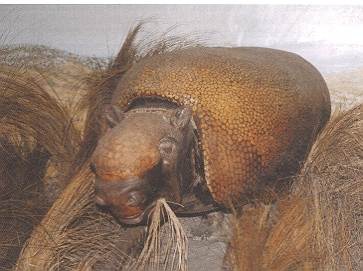
Sclerocalyptus (reconstrucción). Museo de La Plata.
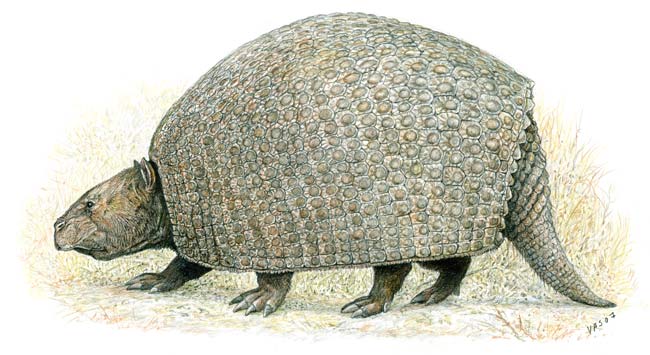
Parapropalaehoplophorus septentrionalis.
So, where does that leave us with regard to the proboscides of macraucheniid litopterns, you might naturally ask? When I directly inquired of Naish’s thoughts about the trunk that is so often shown on the model (directly below) of the camel-like Macrauchenia, which we have discussed before, he replied:
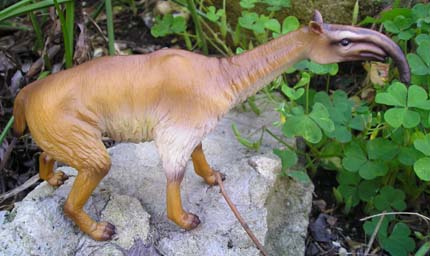
“I had to think hard about Macrauchenia when supervising reconstructions for a kid’s book a while ago, and I can’t say that I am impressed with the evidence for a trunk: so far as I can recall, it actually lacks the muscle attachment sites present in living mammals that have trunks. I…have a long article on them in preparation….I have yet to make up my mind.”
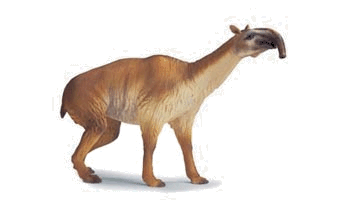
Will Naish crush the childhood memories, past and future, of thoughts about the beautifully and strangely trunked Macrauchenia? Only time will tell.
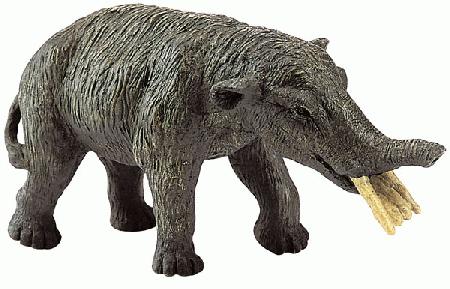
Munns and Naish, however, are able to be in agreement, at least, that mastodons, mammoths and other fossil elephants had trunks. 🙂

Others are still reviewing this entire area. The old H. Osborn 1910 reconstruction of Deinotherium has been revived (as seen above) by Markov et al. (Markov, G. N.; Spassov, N.; and Simeonovski, V. “A reconstruction of the facial morphology and feeding behavior of the deinotheres.” The World of Elephants, International Congress, Rome 2001).
According to Emile’s good blog posting on this, from a study of the skull’s shape, Markov et al. deduced that Deinotherium apparently had a short, tapir-like snout hanging over its descending lower jaw.
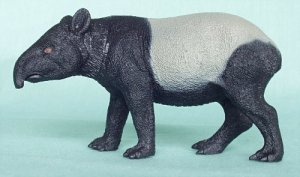
Even today, Munns and Naish would be forced to agree, due to reality, that among various unique animals, trunks are represented on the likes of modern elephant seals, elephants and the routinely strange tapirs!
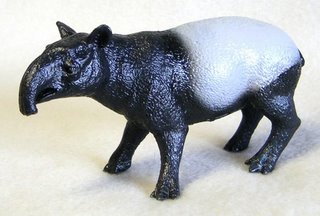
^^^^^^^^^^^^^^^^^^^^^^^^^^^^^^^^^^^^^^^^^^^^^^^^^^^^
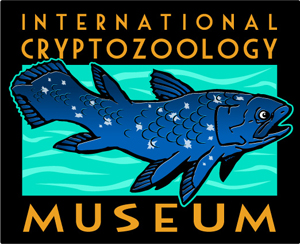
Since June 26th, over 150 different people have contributed (averaging a bit over $30 each), and the donation drive got off to a great start. Even two benefactors, at $1000 and $1050 pitched in, but donations have dropped off to almost zero since July 3rd.
Please donate to the museum, and remember you may directly send a check, money order, or, if outside the USA, an international postal money order made out the “International Cryptozoology Museum,” via snail mail to
International Cryptozoology Museum
c/o Loren Coleman
PO Box 360
Portland, ME 04112
Or with the click of a button, electronically contribute.
Please “Save The Museum”! Easy-to-use donation buttons are now available here or merely by clicking the blank button below, which takes you to a donation site without your being a member of PayPal. Thank you, everyone!
About Loren Coleman
Loren Coleman is one of the world’s leading cryptozoologists, some say “the” leading living cryptozoologist. Certainly, he is acknowledged as the current living American researcher and writer who has most popularized cryptozoology in the late 20th and early 21st centuries.
Starting his fieldwork and investigations in 1960, after traveling and trekking extensively in pursuit of cryptozoological mysteries, Coleman began writing to share his experiences in 1969. An honorary member of Ivan T. Sanderson’s Society for the Investigation of the Unexplained in the 1970s, Coleman has been bestowed with similar honorary memberships of the North Idaho College Cryptozoology Club in 1983, and in subsequent years, that of the British Columbia Scientific Cryptozoology Club, CryptoSafari International, and other international organizations. He was also a Life Member and Benefactor of the International Society of Cryptozoology (now-defunct).
Loren Coleman’s daily blog, as a member of the Cryptomundo Team, served as an ongoing avenue of communication for the ever-growing body of cryptozoo news from 2005 through 2013. He returned as an infrequent contributor beginning Halloween week of 2015.
Coleman is the founder in 2003, and current director of the International Cryptozoology Museum in Portland, Maine.
Filed under Artifacts, Breaking News, Cryptomundo Exclusive, Cryptotourism, CryptoZoo News, Cryptozoologists, Cryptozoology, Evidence, Extinct, Forensic Science, Fossil Finds, Living Dinosaurs, Megafauna, Men in Cryptozoology, Mokele-Mbembe, Museums, Replica Cryptia